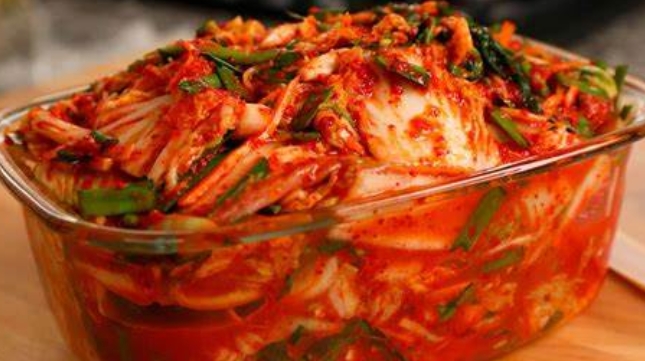Kimchi is one of the cornerstones of Korean cuisine, beloved by people of all ages and served in nearly every meal. This traditional fermented dish is made primarily from cabbage or radish, seasoned with a blend of garlic, ginger, chili pepper, and fish sauce, and then left to ferment for a period of time. The result is a spicy, tangy, and umami-rich dish that can be enjoyed on its own or as an accompaniment to almost any Korean meal.
The making of kimchi dates back over two thousand years, and it has evolved into a symbol of Korean culture and culinary heritage. While there are many varieties of kimchi depending on the region and season, the most common and well-known form is baechu kimchi, made with napa cabbage. The cabbage is salted, then coated with a thick, spicy paste made from gochugaru (Korean red pepper flakes), garlic, ginger, and a fermented shrimp or fish sauce. This paste is what gives kimchi its signature bold, spicy kick.
Once coated, the cabbage is packed into jars or containers and left to ferment at room temperature for a few days. The fermentation process allows the flavors to deepen and the dish to develop a unique tanginess. Depending on how long it ferments, kimchi can range from mild to intensely spicy, and the texture can vary from crispy and crunchy to soft and sour. The longer the kimchi sits, the more pronounced the flavors become, with the fermentation enhancing the dish’s complexity and richness.
Kimchi is not just spicy and tangy; it’s also healthful. The fermentation process encourages the growth of beneficial probiotics, which are great for gut health. Kimchi is rich in vitamins, particularly vitamin A and vitamin C, and contains antioxidants that can support the immune system. It’s low in calories yet packed with flavor, making it a popular choice for those looking for a healthy, flavorful addition to their diet.
Kimchi is traditionally eaten with rice, but it can also be enjoyed in a variety of other ways. It’s often used as a side dish (banchan) to accompany a Korean meal, adding a spicy, tangy contrast to the main dishes like bulgogi (marinated beef) or bibimbap (mixed rice). It can also be used as an ingredient in other dishes, such as kimchi jjigae (kimchi stew), kimchi fried rice, or even kimchi pancakes. The versatility of kimchi makes it an indispensable ingredient in Korean cuisine.
In addition to cabbage-based kimchi, there are many variations made with different vegetables and flavors. For example, kkakdugi is a type of kimchi made with diced radishes, while oi sobagi is a cucumber-based version. Each variety brings its own unique texture and flavor, and there’s no one-size-fits-all approach to making kimchi. It’s a dish that reflects the diverse and creative nature of Korean food.
Kimchi is also a dish that brings people together. It’s commonly made at home during the winter months in a tradition known as kimjang, where families and communities come together to prepare large batches of kimchi. This communal activity is a time to bond, share stories, and preserve an important part of Korean culture. Many families have their own special recipes, passed down through generations, which are considered family secrets.
Though kimchi is a staple in Korean homes, its popularity has spread beyond Korea. In recent years, kimchi has gained recognition as a superfood, loved by food enthusiasts and health-conscious individuals around the world. Its distinct flavor and health benefits have led to its incorporation into global fusion cuisines, where it’s often featured in sandwiches, tacos, burgers, and even pizza.
One of the reasons kimchi is so beloved is because of its boldness and complexity. Its balance of spicy, sour, salty, and umami flavors makes it an unforgettable addition to any meal. The combination of chili, garlic, and fermented seafood gives kimchi a depth of flavor that’s hard to find in other dishes. The probiotics that develop during fermentation also give kimchi a tangy richness that’s both appetizing and addictive.
As with many fermented foods, kimchi gets better with age. Over time, the flavor of the kimchi continues to evolve, with a deeper complexity that is appreciated by kimchi aficionados. Some people prefer it fresh, with a crisp and lively flavor, while others enjoy it after a few weeks or even months, when it’s fully fermented and develops a more pronounced sourness.
Ultimately, kimchi is more than just a dish—it’s a cultural symbol, a reflection of Korea’s deep-rooted traditions, and a flavorful expression of community. Whether served as a side dish, incorporated into main meals, or enjoyed on its own, kimchi is a dish that brings people together, nurtures the body, and excites the palate.





